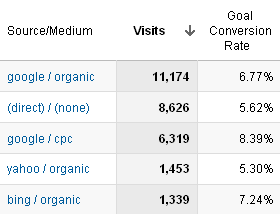At the end of the year, Google rolled out a new version of Analytics which included a completely redesigned interface as well as some new features. With the shiny new interface and fun motion graphics, it’s easy to overlook some of the less flashy changes but there are a few that are extremely impactful. One in particular is event goals.
Event goals marry two existing concepts:
Goal Conversions – A fundamental feature of Analytics is the ability to track a goal completion. Traditionally this completion is tracked by a URL destination or other pageview based determination. For example, you could track the conversion numbers on a signup form by tracking the number of times users reached the “thank you” page after completing the form.
Event Tracking – For a while now, Analytics has also had the ability to track an event or an action performed by a user. Where traditional Analytics tracking was based on a pageview, event tracking added the ability to track a user’s action that was not related to a pageview such as a file download or interaction with a media player or flash animation.
 Enter the event goal. Once your event tracking is in place you can now easily tie it to a goal by selecting the “Event” type when setting up your goal. Now you can cross reference your events with all of your other data just like a traditional goal.
Enter the event goal. Once your event tracking is in place you can now easily tie it to a goal by selecting the “Event” type when setting up your goal. Now you can cross reference your events with all of your other data just like a traditional goal.
If you are already monitoring your website goal conversions keep up the good work but do take this opportunity to audit your current setup and see if there might be an even better way to track your marketing efforts.
One word of caution, currently you cannot use an event goal in conjunction with a goal funnel. For example, if you want to track the users who download a PDF after navigating down a specific funnel, the final step of your goal completion must be set up using one of the older methods.

